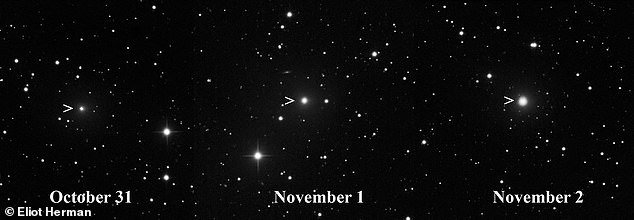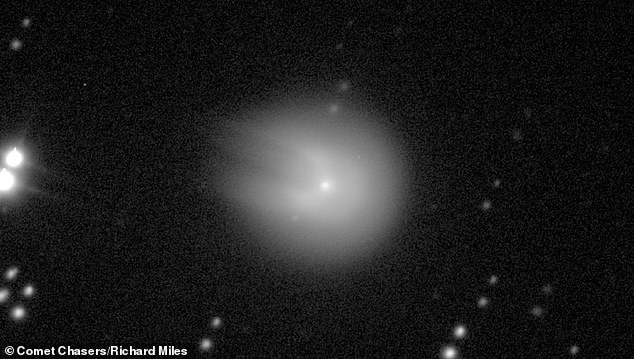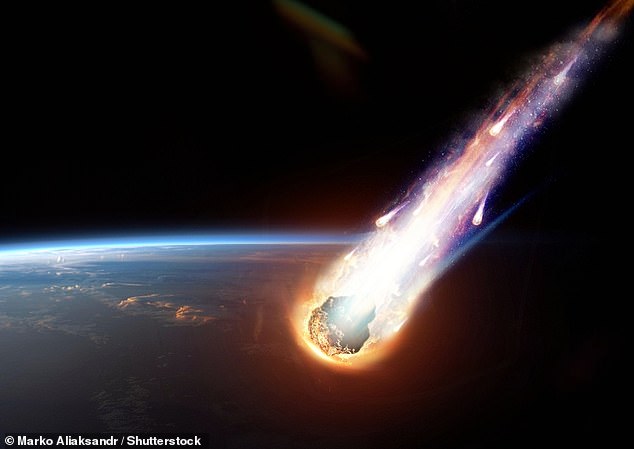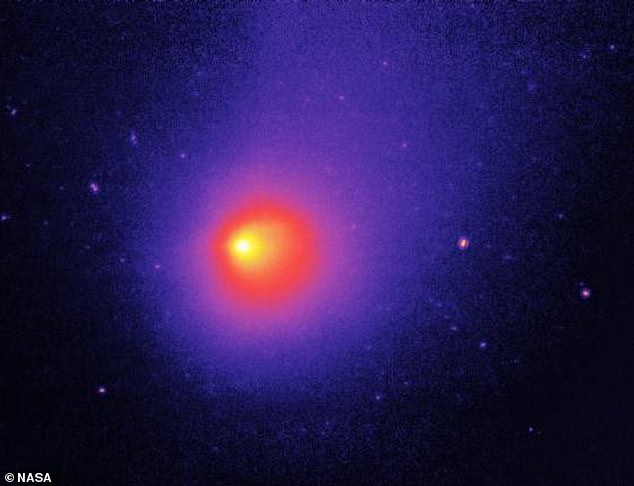Beware the ‘devil comet’: Huge space rock three times the size of Mount Everest that is racing towards Earth has sprouted ‘horns’, scientists say
>
A massive ‘devil’ comet more than three times the size of Mount Everest has exploded again as it heads towards Earth.
The space rock, called 12P/Pons-Brooks, is about 18 miles in diameter, and is described as a “cold volcano” because it is violently spewing ice and gas.
These explosions create a cascade of material as they hurtle through space at thousands of miles per hour, much like a pair of devil’s horns.
The comet, which was first discovered in 1812, is scheduled to reach the closest point in its orbit to Earth in June 2024, although fortunately it will not come close enough to pose a danger to humans.
When this close approach occurs, 12P/Pons-Brooks is expected to be visible to the naked eye as a faint star-like blob with a fuzzy tail.
According to an astronomer, the comet erupted on October 31, the second time in a calendar month.

Elliot Herman, an amateur astronomer based in Arizona, said the comet suddenly brightened nearly 100 times on October 31 and continued to increase in brightness in the following days.
Comets consist of a core made of ice, dust and small rocky particles, surrounded by an outer “coma” – a murky cloud of gases.
12P/Pons-Brooks is what is known as a cold volcanic comet, or cold volcano, which means it exhibits volcanic activity.
But instead of spewing molten rock and lava like a volcano on Earth, a cryovolcanic comet spews a mixture of gases and ice.
When a cold, volcanic comet approaches the Sun — as 12P/Pons-Brooks is doing now — it heats up, causing increased pressure in the core.
Pressure continues to build until nitrogen and carbon monoxide explode, spewing icy debris through large cracks in the core’s crust.
These gaseous streams can form distinctive shapes when viewed through a telescope, such as devil’s horns, also described as a horseshoe or the Millennium Falcon from Star Wars.
It suddenly brightened nearly 100-fold on October 31 and continued to grow brighter in the following days, said Elliot Herman, an amateur astronomer based in Arizona, who was observing the comet.
This is an indication of a new flurry of cryovolcanic activity and the growth of centuries.

Some have speculated that the horseshoe-like shape also resembles the Millennium Falcon spaceship in Star Wars

Comets are composed of ice, dust, and rocky materials, and differ from asteroids, which are composed of metals and rocky materials (concept image)
This marks the second 12P/Pons-Brooks outburst in a calendar month, and the third since July.
“This comet has been widely mentioned in the news as the ‘Devilish Comet’ because of two previous explosions that gave rise to a horned devil,” Herman said..
“On Halloween, the devil exploded again with a huge eruption that lasted until the next day.”
Just like the planets, comets in our solar system orbit the Sun because they are attracted by the Sun’s immense gravitational force.
It takes 12P/Pons-Brooks 71 years to complete an orbit around the Sun, but this is relatively short compared to the orbital length of most orbits, which take thousands of years.
Comets usually have very “elliptical” orbits, meaning they are rectangular rather than perfectly circular.
These elliptical orbits put them very close to the Sun at one point in their orbit (perigee) and very far from the Sun at another point (aphelion).
Like all orbiting objects, the closer comets are to the Sun, the faster their speed.
Comet Devil 12P/Pons-Brooks is currently hurtling toward the Sun — and thus Earth as well — at more than 40,000 miles per hour (20 kilometers per second).

Pons Brooks is not the most volatile volcanic comet in the solar system. That honor goes to 29P/Schwassmann-Wachmann volcano (pictured), which is thought to erupt about 20 times a year
But this speed can increase to more than 100,000 miles per hour as it approaches the sun, known as perihelion.
12P/Pons-Brooks is scheduled to approach the Sun by 72.5 million miles (116.8 million km) on April 21 next year.
Then, a close approach to Earth of 144 million miles (232 million km) will occur on June 2.
As it continues to head toward Earth, the space rock will likely continue to explode, perhaps more violently than it already has.
After it reaches its closest point to us, this space rock will return under the force of gravity to the outer solar system and will not return until 2095.
(Tags for translation)dailymail
